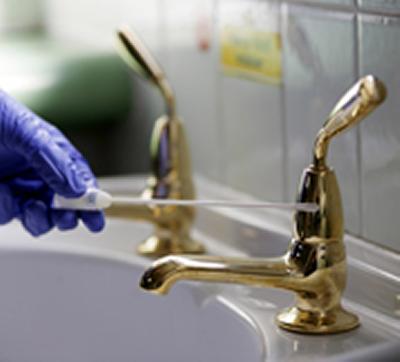Hospital trial shows copper reduces contamination

Research conducted at the University of Southampton has paved the way for a hospital trial that has shown that surfaces made with materials that contain copper kill a wide range of potentially harmful micro-organisms - significantly reducing the number of these organisms that can come into contact with patients, visitors and staff.
Results from the study carried out at Selly Oak Hospital in Birmingham show that, when tested, items made from copper had up to 95 per cent fewer micro-organisms on them, compared with the same items made out of standard materials such as stainless steel.
The study, begun in March last year, was a collaboration between eminent microbiologists Professor Bill Keevil, of the University of Southampton, Professor Peter Lambert at Aston University, Birmingham, and Professor Tom Elliott, a consultant microbiologist and Deputy Medical Director at University Hospitals Birmingham NHS Foundation Trust, which runs Selly Oak Hospital.
Laboratory tests previously conducted by Professor Keevil at Southampton had established that the natural antimicrobial properties of copper and copper alloys dramatically reduce the presence of MRSA compared with stainless steel, the most commonly used surface-metal in health institutions. The MRSA bacteria on stainless steel remained fully active for days. On brass (an alloy of copper and zinc) they died in less than 5 hours and on pure copper, the superbugs were eliminated in 30 minutes.
To follow up these findings, in the first clinical study of its kind, items that contained copper, including taps, door push-plates, grab-handles, a toilet seat and a bedside trolley were specially made by local manufacturers and placed in a ward at Selly Oak Hospital.
In the main element of the study, the items were swabbed twice a day, along with similar items made with conventional materials. The samples were taken to Aston University where they were examined to see how many micro-organisms were present.
After five weeks, the items were swapped over and tested for another five weeks. This unique 'crossover' technique was designed to eliminate potential bias caused by the items being used in different locations and so in different ways.
Professor Keevil, Director of the Environmental Healthcare Unit at the University of Southampton, commented: "It appears that the copper reacts with the organisms and inhibits the respiration of the cells and destroys their DNA.

"Given that in the trial 90 to 95 per cent of the micro-organisms were killed, even after a busy day on a medical ward with items being handled and touched by a large number of people, copper may well offer us another weapon in the battle to defeat the spread of infection."
Professor Elliot, who led the study, said: "What this must mean is that the risk of picking up an infection is reduced, because we know that one of the vehicles where organisms can spread from one surface to another is by touching them. So the results are very exciting.
"Copper is what I would call an intelligent metal. The copper is quietly working away in the background, killing organisms all the time. It needs to be part of what we call a bundle of care in terms of an approach to preventing infection. This gives us another arm, another weapon to fight infection which is around us and challenging us all the time. So I would see this in addition to the measures we are taking at the moment."
Professor Lambert added: "While no MRSA was found either on the copper-containing surfaces or the standard items, because the findings strongly mirror the results of the laboratory trials, it is safe to assume that copper in a clinical environment would be just as effective against MRSA."
A larger study to establish how the potential benefits of using copper might best be realised will start next year.
The findings were presented by Professor Elliott at the prestigious Interscience Conference on Antimicrobial Agents and Chemotherapy (ICAAC) in Washington DC, USA, which attracts 10,000 delegates from around the world, this afternoon (Tuesday, October 28).
The study was funded by an education grant provided by the Copper Development Association in the United Kingdom.